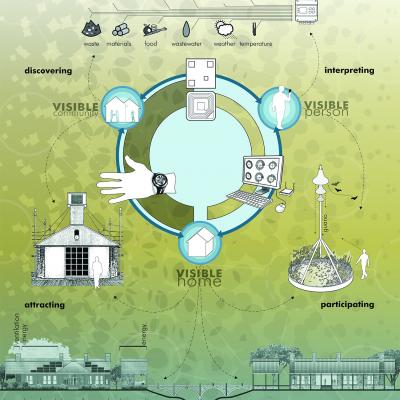Visible Green
Sharing information is key to creating a green world. Visible Green is a visualization protocol which exposes articulated (“visible”) green and promotes subversive (“invisible”) green. Visible Green functions at three scales--person, home and community--and through four primary techniques--discovery (through feedback), interpretation (using codification), attraction (via design), and participation.
Making the invisible visible is one of the Center's long-standing principles. Visible Green is a program enabled through the two-dimensional QR (quick response) code technology that enables detailed information to be accessed through a cell phone application. The data "tell the life cycle story" of how and why something is green--such as its CO2 or water footprint. Three Visible Green scales are envisioned: person, home, city. They share a life cycle coding using different metrics for analysis. At the "person" scale, the carbon footprint is based on where money is spent, using a program such as Mint.com and converting money to carbon footprint equivalent. The procedure draws on comparative behavior incentives, comparing an individual's footprint to others in the neighborhood, city or country. At the "home" scale, life cycle events are tagged enabling one to compare performance within a life cycle framework to others. And, at the "city" scale, the codes reveal where and how green products are manufactured, sold and used, based on the life cycle categories of air, water, food, energy and materials. As QR codes become more prevalent in the U.S., this approach offers a powerful entry point in sharing key performance information to the broad public.
FUNDING:
The Kendeda Fund
PROJECT TEAM:
Pliny Fisk III; Lovleen Gill-Aulakh
01

